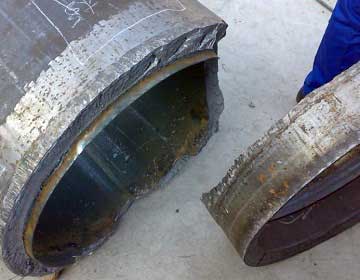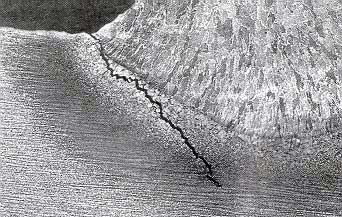 |
Hydrogen Induced Cracking of pipeline and pressure vessel steels |
Pipelines and pressure vessels made of carbon steel and low-alloy steel can exhibit hydrogen-induced cracking (Hydrogen Induced Cracking, HIC) in a wet environment with hydrogen sulfide in the oil and gas industry.
Pipelines and pressure vessels made of carbon steel or low-alloy steel suffer from cracks in acidic environments due to hydrogen-assisted cracking (HAC) process. Cracks usually occur on the metal surface or at defects within the metal thickness. When hydrogen diffuses into metal and occupies interstitial locations, it degrades the mechanical properties of the metal, making the material susceptible to cracking at stresses lower than yield stress, which applies to all HAC processes.
In terms of damage mechanisms, HIC is usually, but not always, fairly harmless. It is usually not harmful until it becomes extensive and affects material properties. Over time, these cracks tend to couple together as a result of internal pressure build-up and possibly localized stress fields in damaged areas, often propagating in a weld or propagating in the through-thickness direction (also called "incremental" cracking).
Many variables determine the likelihood of wet H2S damage during operation, including HIC. Moreover, there are many different nuances related to process conditions/pollutants, welding/steel fabrication methods, applied/residual stress fields, etc. that promote different forms of wet H2S cracking or blistering.
Several refining process units are clearly susceptible to wet H2S damage such as HIC, including but not limited to FCCUs (Fluid Catalytic Cracking Units), amine units, sulfur recovery units and acid water stripper units. In FCCUs, light end (overhead) recovery/fractionation equipment and especially locations downstream of wet gas compressors, intercoolers/chillers, knockout drums, sponge absorbers and desulfurizers have traditionally been problem areas. Absorbers/contactors of amine treatment plants (especially near acid gas inlet nozzles) and overhead equipment of the acid water stripper plant (e.g., condensers and backflow drums) are also particularly sensitive.
 Image.. www.metalspiping.com
Image.. www.metalspiping.com
 Image.. www.twi-global.com
Image.. www.twi-global.com
Detecting Hydrogen Induced Cracking
On the surface, HIC is often horseshoe-shaped and no larger than the epidermis of your little finger. Regular inspection and testing should be performed to eliminate the possibility of hydrogen corrosion. The conventional non-destructive testing (NDT) method for detecting wet H2S cracking is Wet Fluorescent Magnetic Particle Testing (WFMPT), which is sensitive enough to reliably detect fracturing surface cracks in the steel caused by HIC. Ultrasonic testing methods and time of flight diffraction (TOFD) have also proven effective for categorizing and sizing wet H2S damage such as HIC.
Regardless of the NDT method used, it is essential that the limitations and margins of error are well understood and that qualified and experienced inspectors are involved. Again, given the potentially unpredictable or sudden damage progression associated with wet H2S damage mechanisms, it is important to ensure that high-risk equipment, and especially areas with previously observed damage, are routinely inspected.
Detailed Information

By knowing the expected general corrosion rate and the anticipated plant or service life of a part, the designer can calculate the extra thickness...